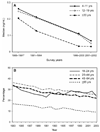Progress and challenges in selected areas of tobacco carcinogenesis
- PMID: 18052103
- PMCID: PMC2556958
- DOI: 10.1021/tx7002068
Progress and challenges in selected areas of tobacco carcinogenesis
Abstract
Tobacco use continues to be a major cause of cancer in the developed world, and despite significant progress in this country in tobacco control, which is driving a decrease in cancer mortality, there are still over 1 billion smokers in the world. This perspective discusses some selected issues in tobacco carcinogenesis focusing on progress during the 20 years of publication of Chemical Research in Toxicology. The topics covered include metabolism and DNA modification by tobacco-specific nitrosamines, tobacco carcinogen biomarkers, an unidentified DNA ethylating agent in cigarette smoke, mutations in the K-RAS and p53 gene in tobacco-induced lung cancer and their possible relationship to specific carcinogens, secondhand smoke and lung cancer, emerging issues in smokeless tobacco use, and a conceptual model for understanding tobacco carcinogenesis. It is hoped that a better understanding of mechanisms of tobacco-induced cancer will lead to new and useful approaches for the prevention of lung cancer and other cancers caused by tobacco use.
Figures







Similar articles
-
Tobacco-specific N-nitrosamines and Areca-derived N-nitrosamines: chemistry, biochemistry, carcinogenicity, and relevance to humans.J Toxicol Environ Health. 1994 Jan;41(1):1-52. doi: 10.1080/15287399409531825. J Toxicol Environ Health. 1994. PMID: 8277523 Review.
-
Aldehydes are the predominant forces inducing DNA damage and inhibiting DNA repair in tobacco smoke carcinogenesis.Proc Natl Acad Sci U S A. 2018 Jul 3;115(27):E6152-E6161. doi: 10.1073/pnas.1804869115. Epub 2018 Jun 18. Proc Natl Acad Sci U S A. 2018. PMID: 29915082 Free PMC article.
-
Tobacco smoke carcinogens and lung cancer.J Natl Cancer Inst. 1999 Jul 21;91(14):1194-210. doi: 10.1093/jnci/91.14.1194. J Natl Cancer Inst. 1999. PMID: 10413421 Review.
-
Exposure and Metabolic Activation Biomarkers of Carcinogenic Tobacco-Specific Nitrosamines.Acc Chem Res. 2016 Jan 19;49(1):106-14. doi: 10.1021/acs.accounts.5b00472. Epub 2015 Dec 17. Acc Chem Res. 2016. PMID: 26678241 Free PMC article.
-
Tobacco smoke promotes lung tumorigenesis by triggering IKKbeta- and JNK1-dependent inflammation.Cancer Cell. 2010 Jan 19;17(1):89-97. doi: 10.1016/j.ccr.2009.12.008. Cancer Cell. 2010. PMID: 20129250 Free PMC article.
Cited by
-
Functional interaction between human papillomavirus type 16 E6 and E7 oncoproteins and cigarette smoke components in lung epithelial cells.PLoS One. 2012;7(5):e38178. doi: 10.1371/journal.pone.0038178. Epub 2012 May 25. PLoS One. 2012. PMID: 22662279 Free PMC article.
-
Lung cancer in Chinese women: evidence for an interaction between tobacco smoking and exposure to inhalants in the indoor environment.Environ Health Perspect. 2010 Sep;118(9):1257-60. doi: 10.1289/ehp.0901587. Epub 2010 May 14. Environ Health Perspect. 2010. PMID: 20472525 Free PMC article.
-
Steroid hormone levels associated with passive and active smoking.Steroids. 2011 Jun;76(7):653-9. doi: 10.1016/j.steroids.2011.02.042. Epub 2011 Mar 17. Steroids. 2011. PMID: 21396948 Free PMC article.
-
DNA adducts: Formation, biological effects, and new biospecimens for mass spectrometric measurements in humans.Mass Spectrom Rev. 2020 Mar;39(1-2):55-82. doi: 10.1002/mas.21570. Epub 2018 Jun 11. Mass Spectrom Rev. 2020. PMID: 29889312 Free PMC article. Review.
-
Household inhalants exposure and nasopharyngeal carcinoma risk: a large-scale case-control study in Guangdong, China.BMC Cancer. 2015 Dec 29;15:1022. doi: 10.1186/s12885-015-2035-x. BMC Cancer. 2015. PMID: 26714970 Free PMC article.
References
-
- World Health Organization. The World Health Report 2003: Shaping the Future. 2003. pp. 91–94.
-
- International Union Against Cancer. 2007. www.deathsfromsmoking.net.
-
- Hecht SS. Carcinogenicity studies of inhaled cigarette smoke in laboratory animals: old and new. Carcinogenesis. 2005;26:1488–1492. - PubMed
Publication types
MeSH terms
Substances
Grants and funding
LinkOut - more resources
Full Text Sources
Other Literature Sources
Research Materials
Miscellaneous

